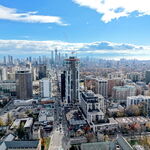ShonTron
Moderator
Member Bio
- Joined
- Apr 24, 2007
- Messages
- 13,139
- Reaction score
- 11,445
- Location
- Ward 13 - Toronto Centre
By far the best example of metrolinx looking after integration is the easy to use Kipling bus terminal and subway station. Perfect execution and attention to details.
The connections are seamless! Mere steps between modes!
But to be serious, the rebuilt Bramalea GO Station is a good example of integrating local transit with the GO network.




